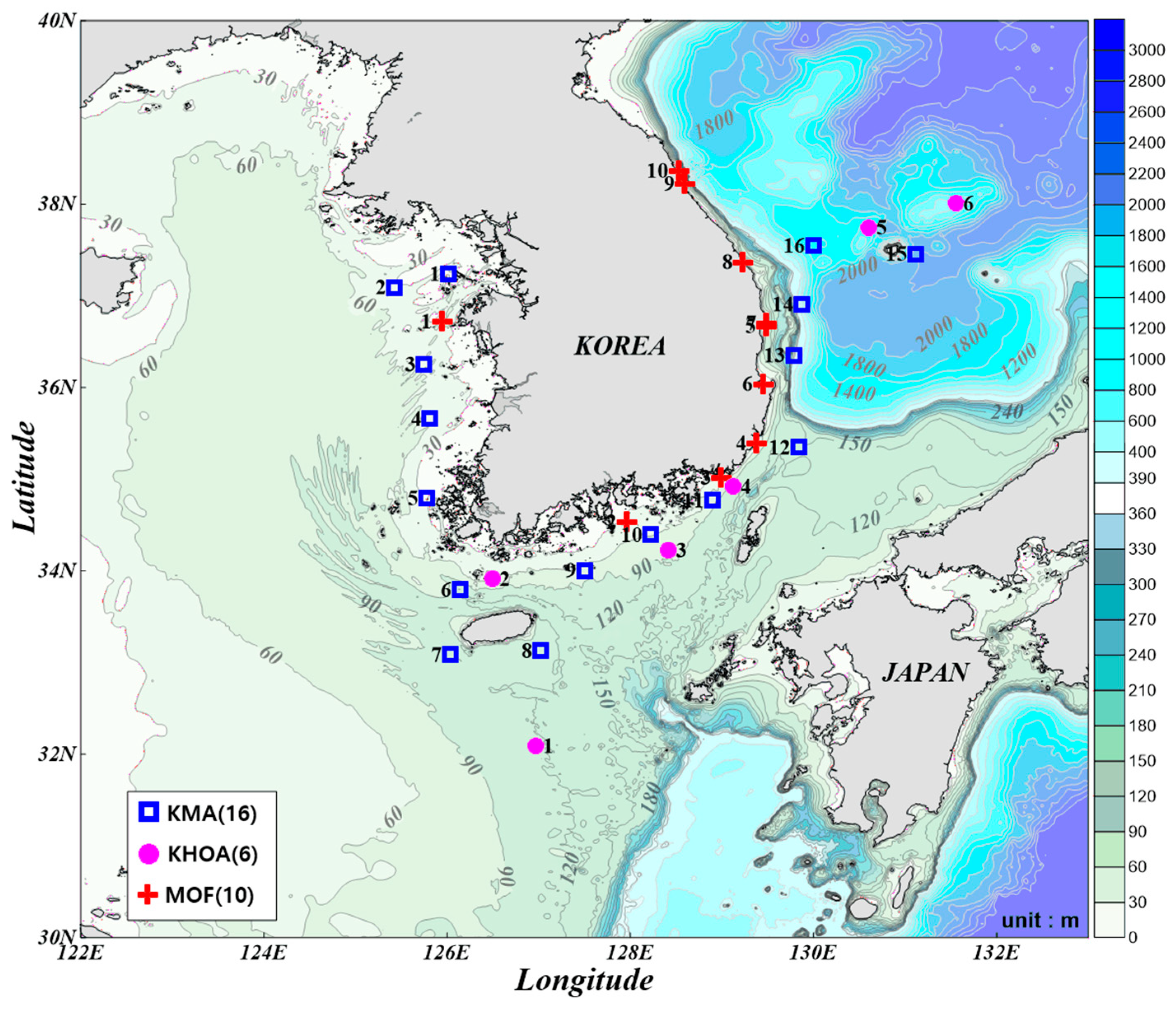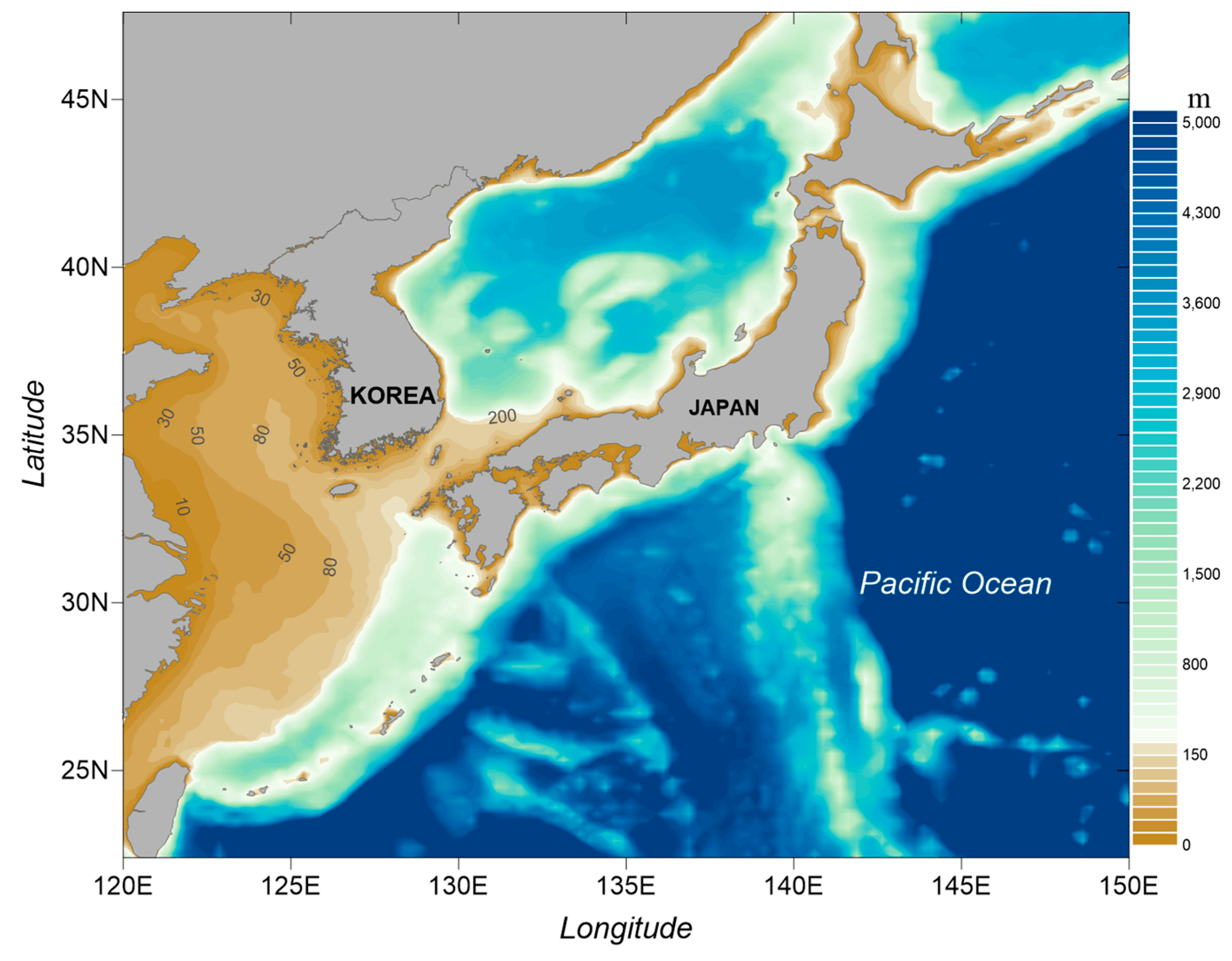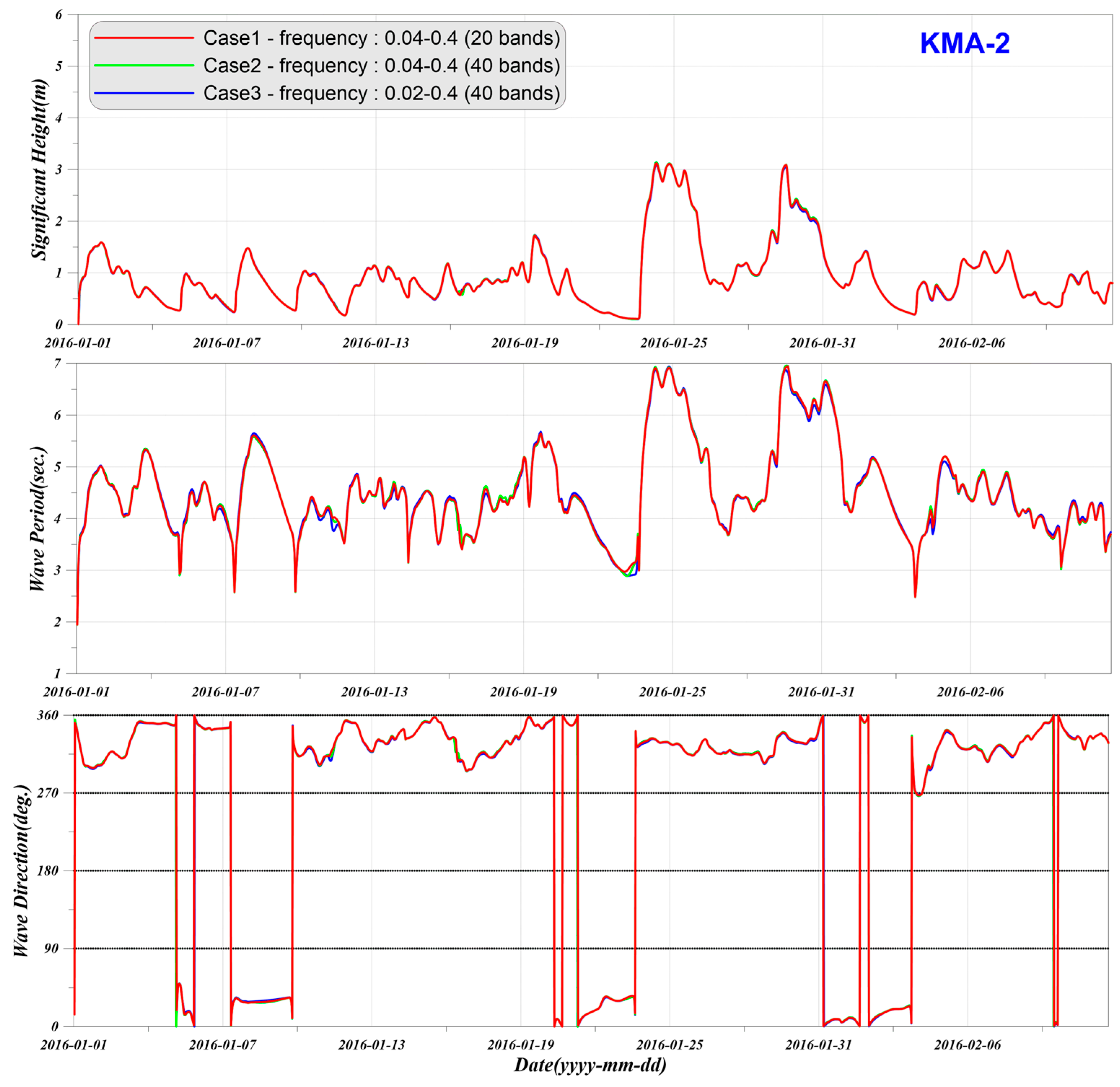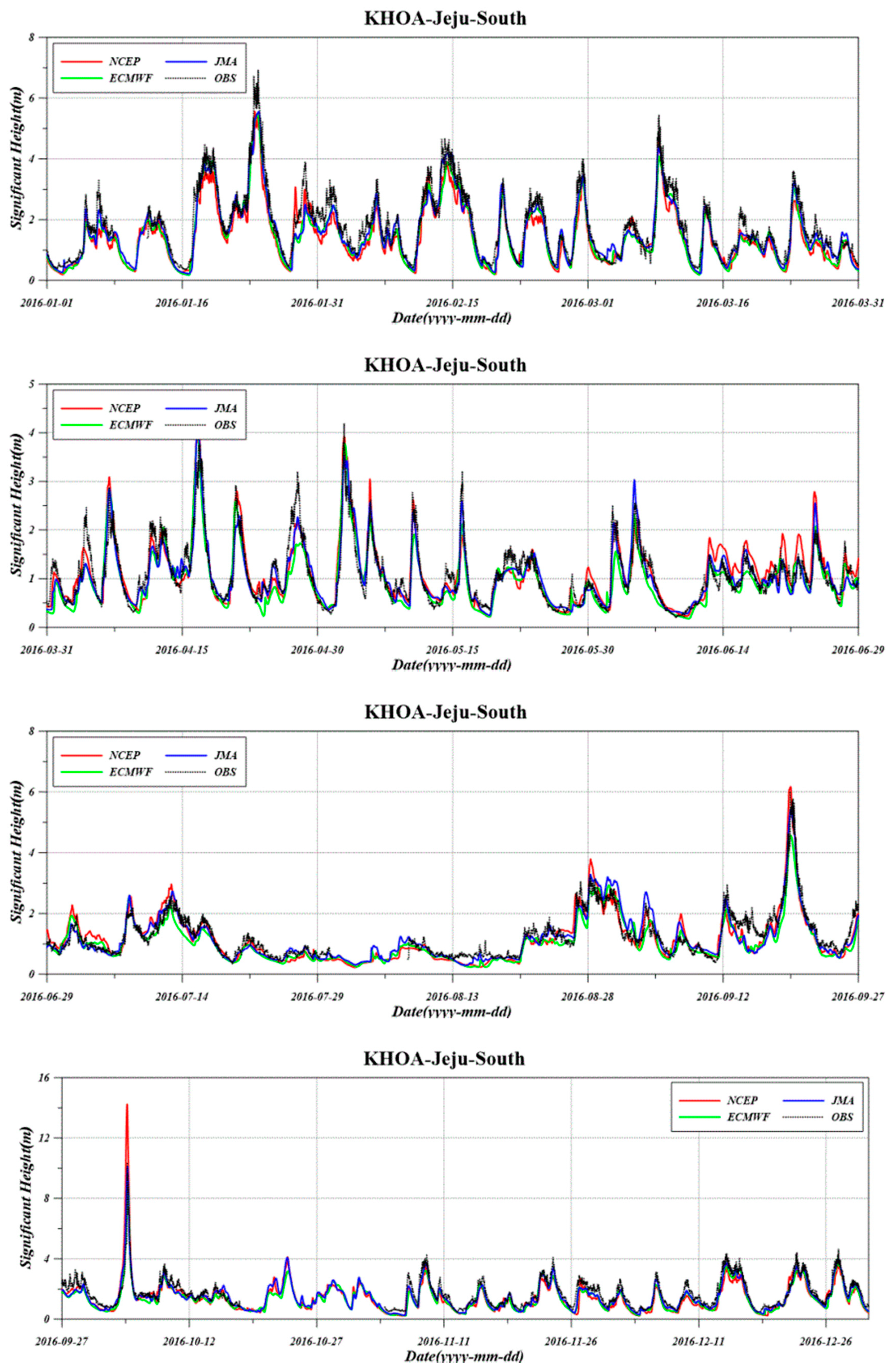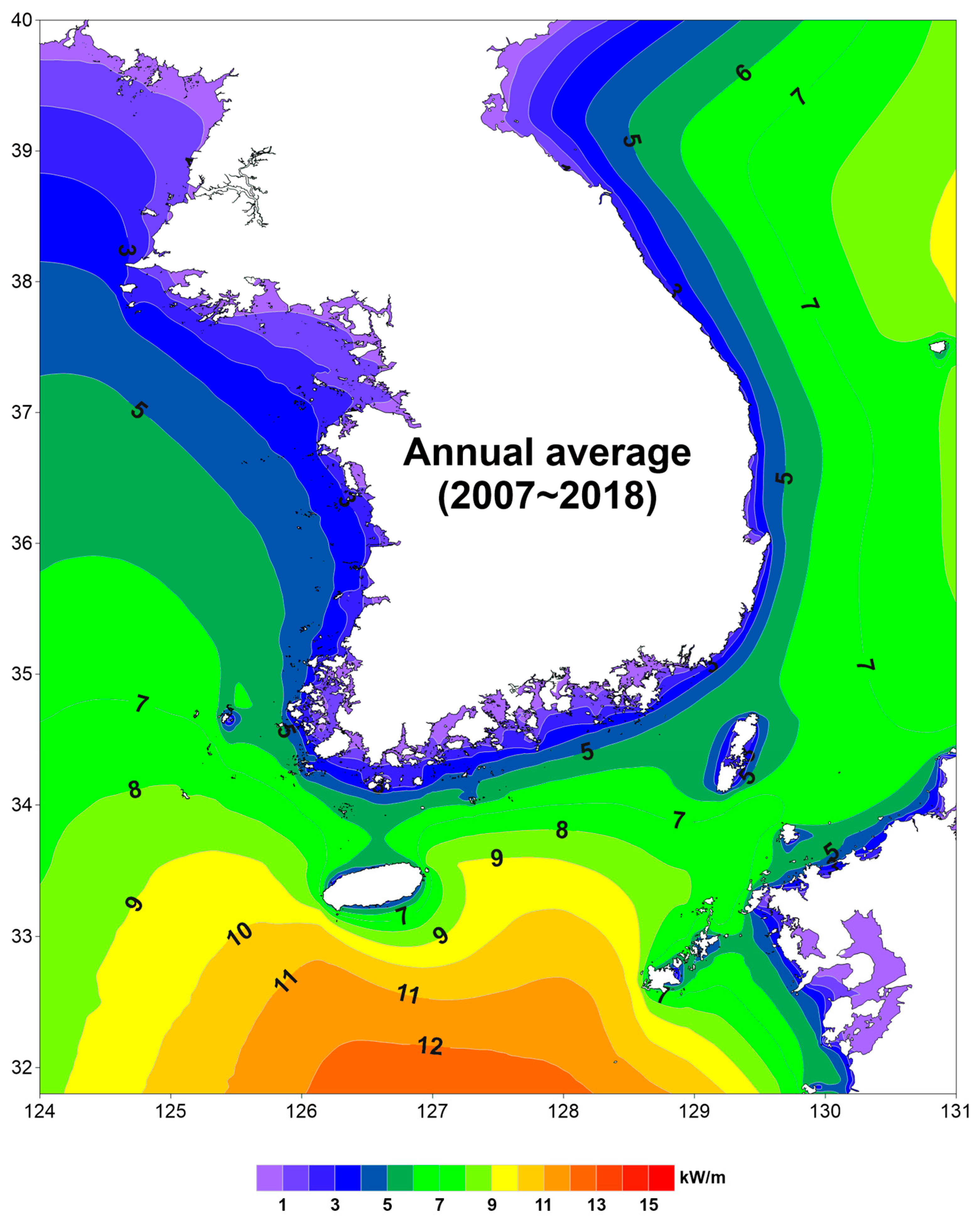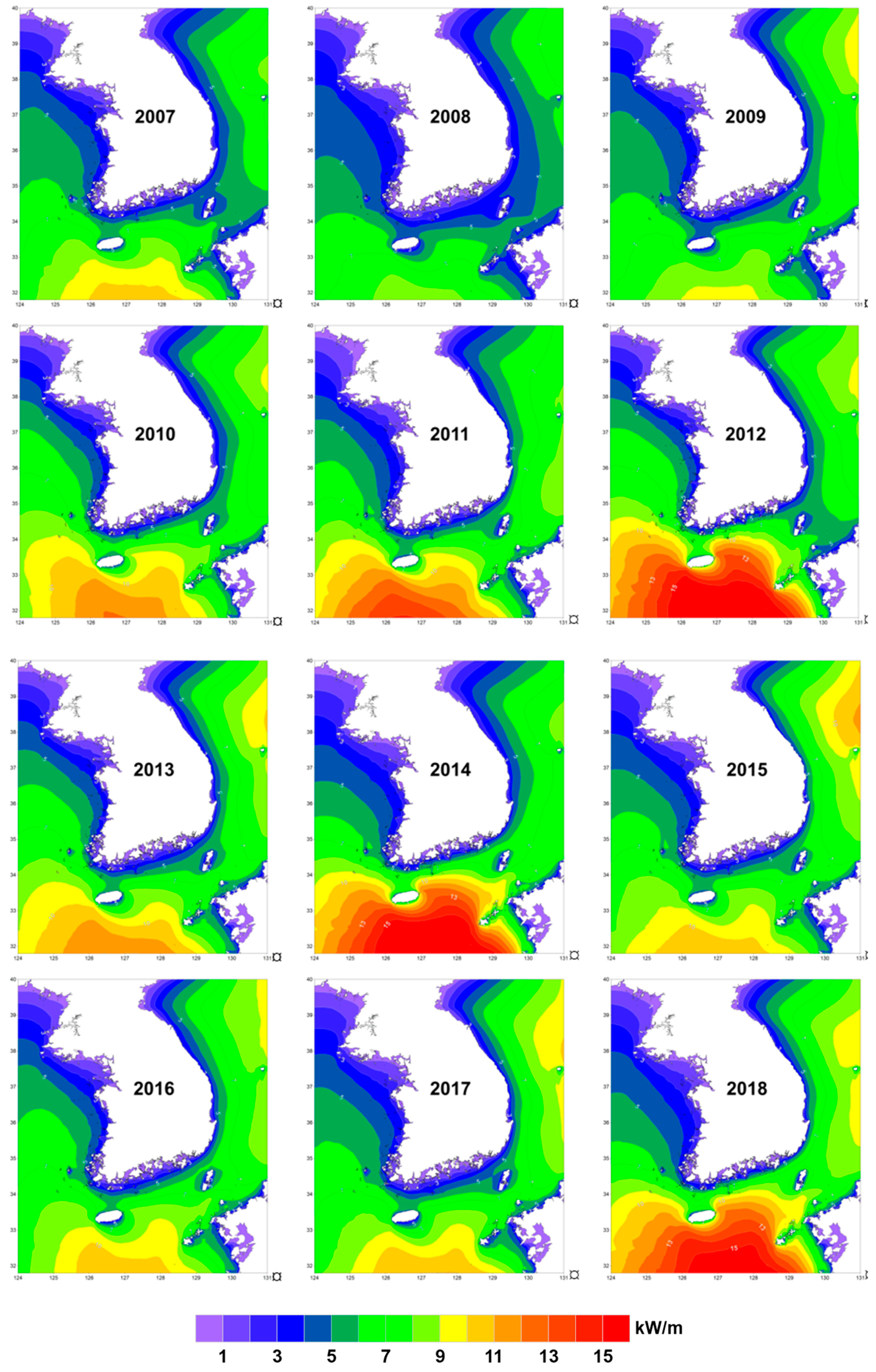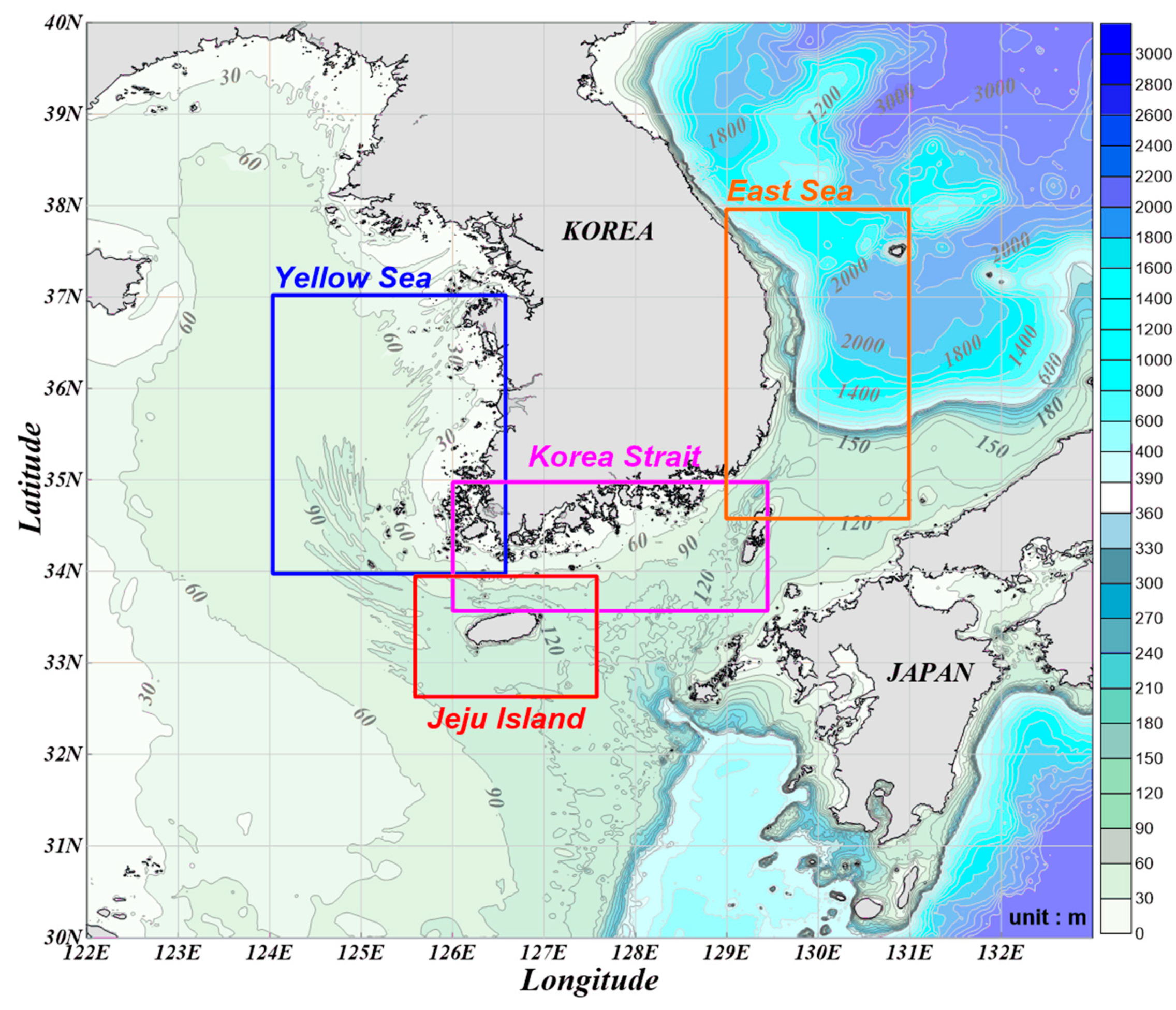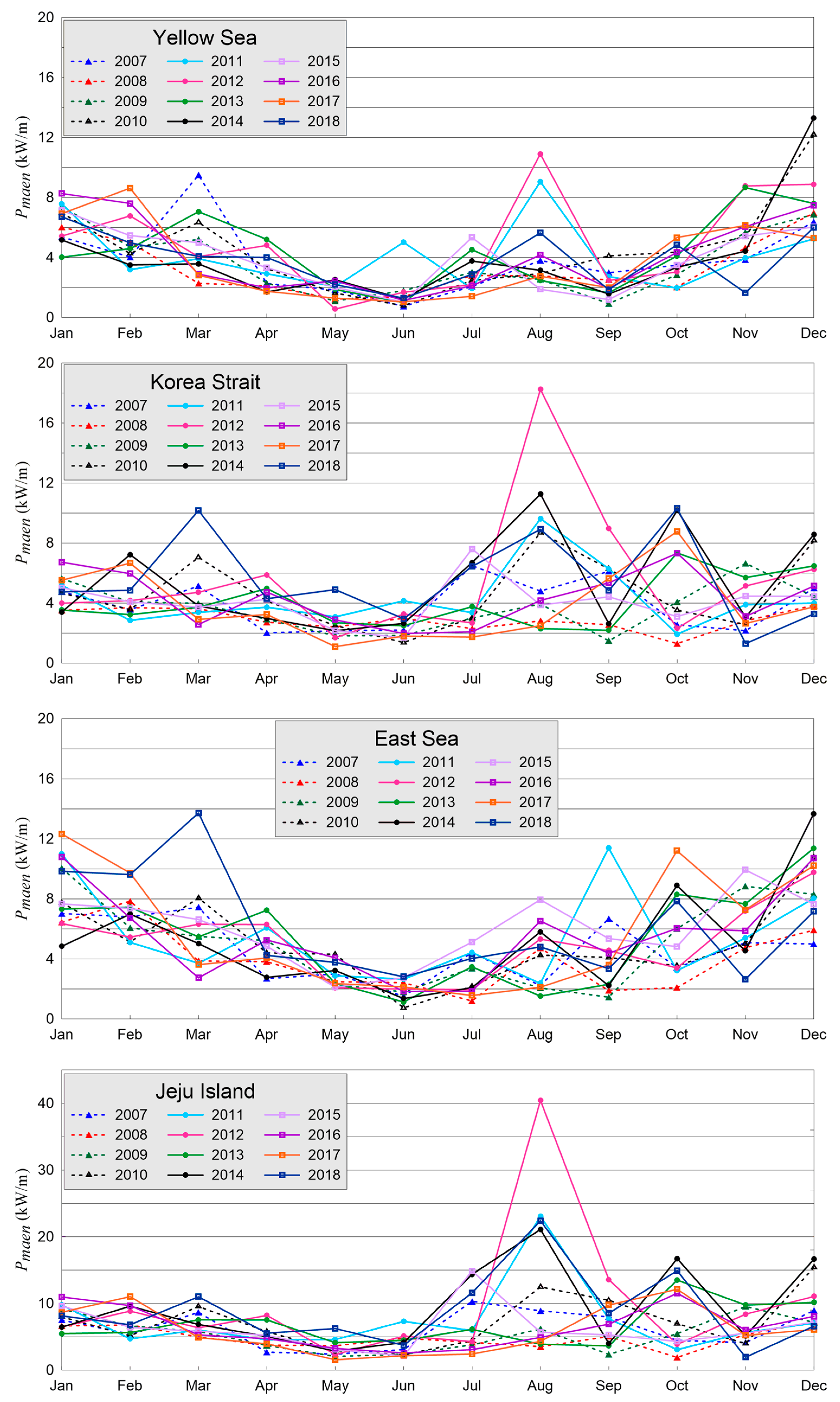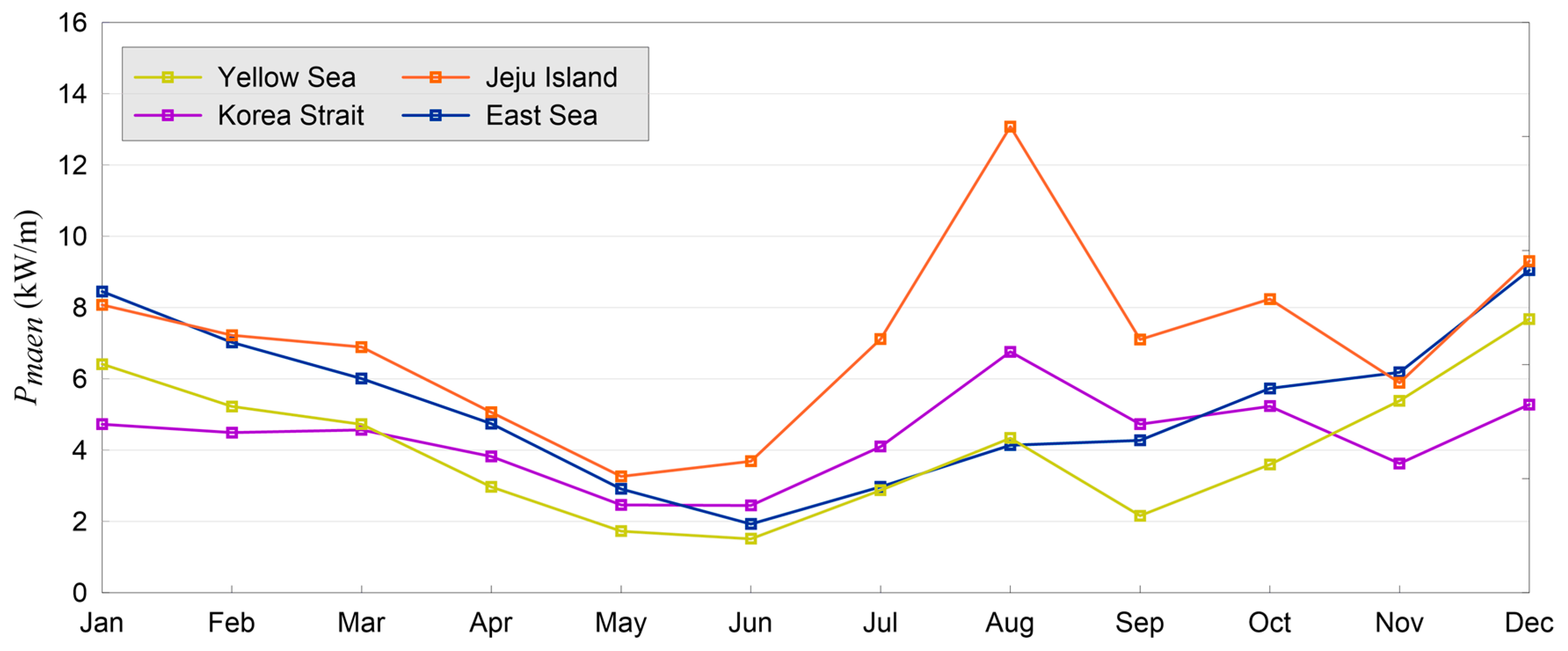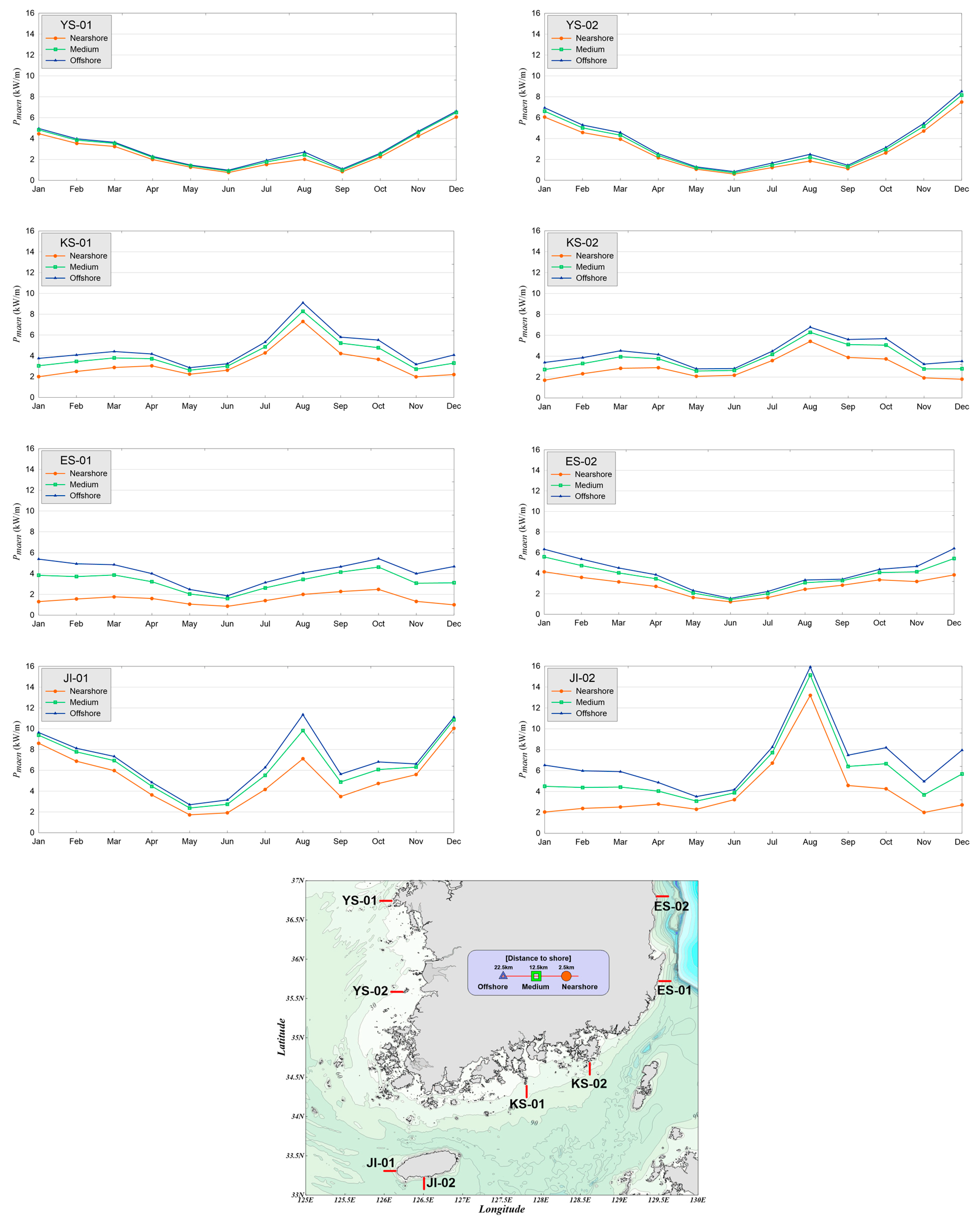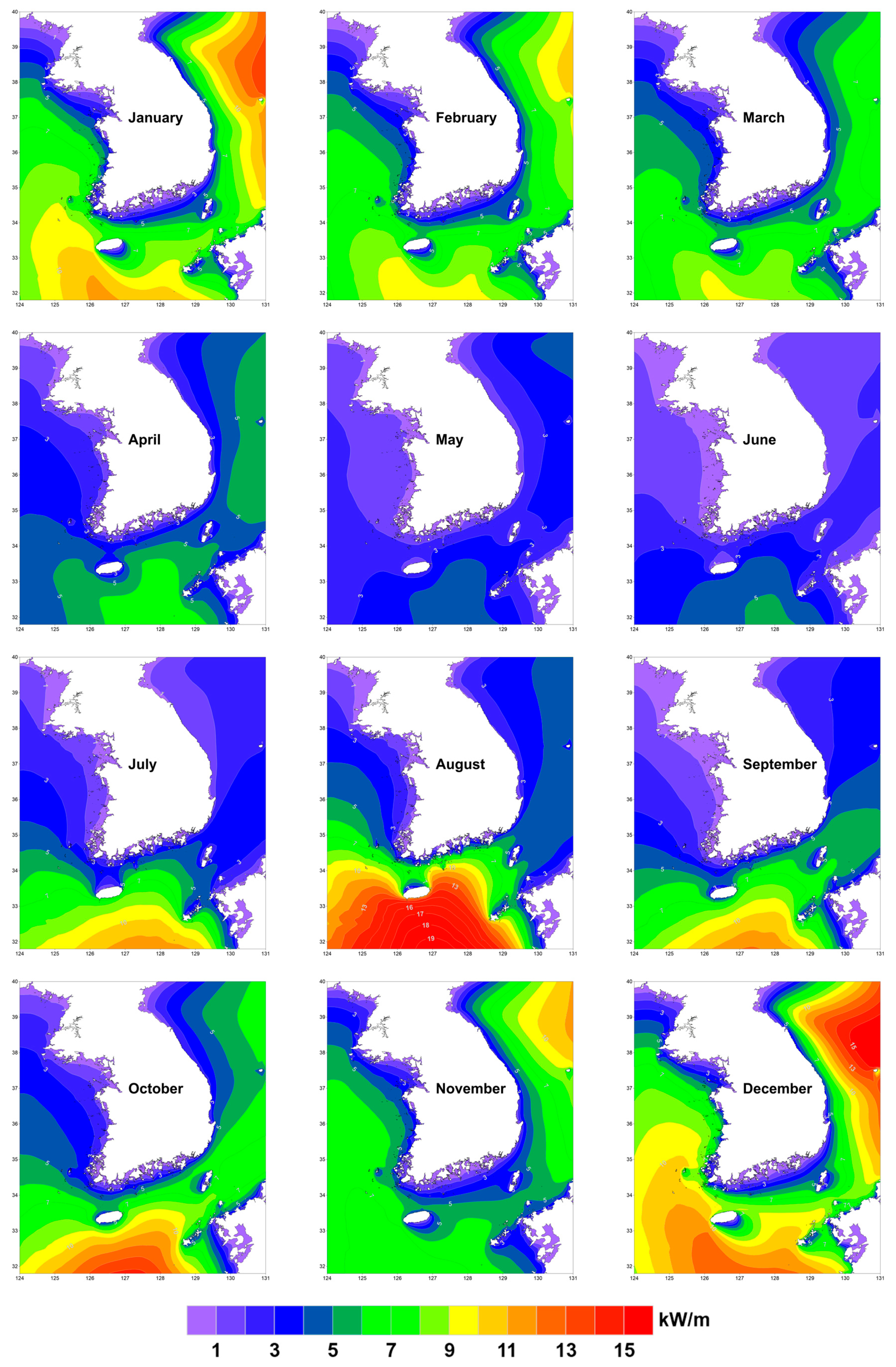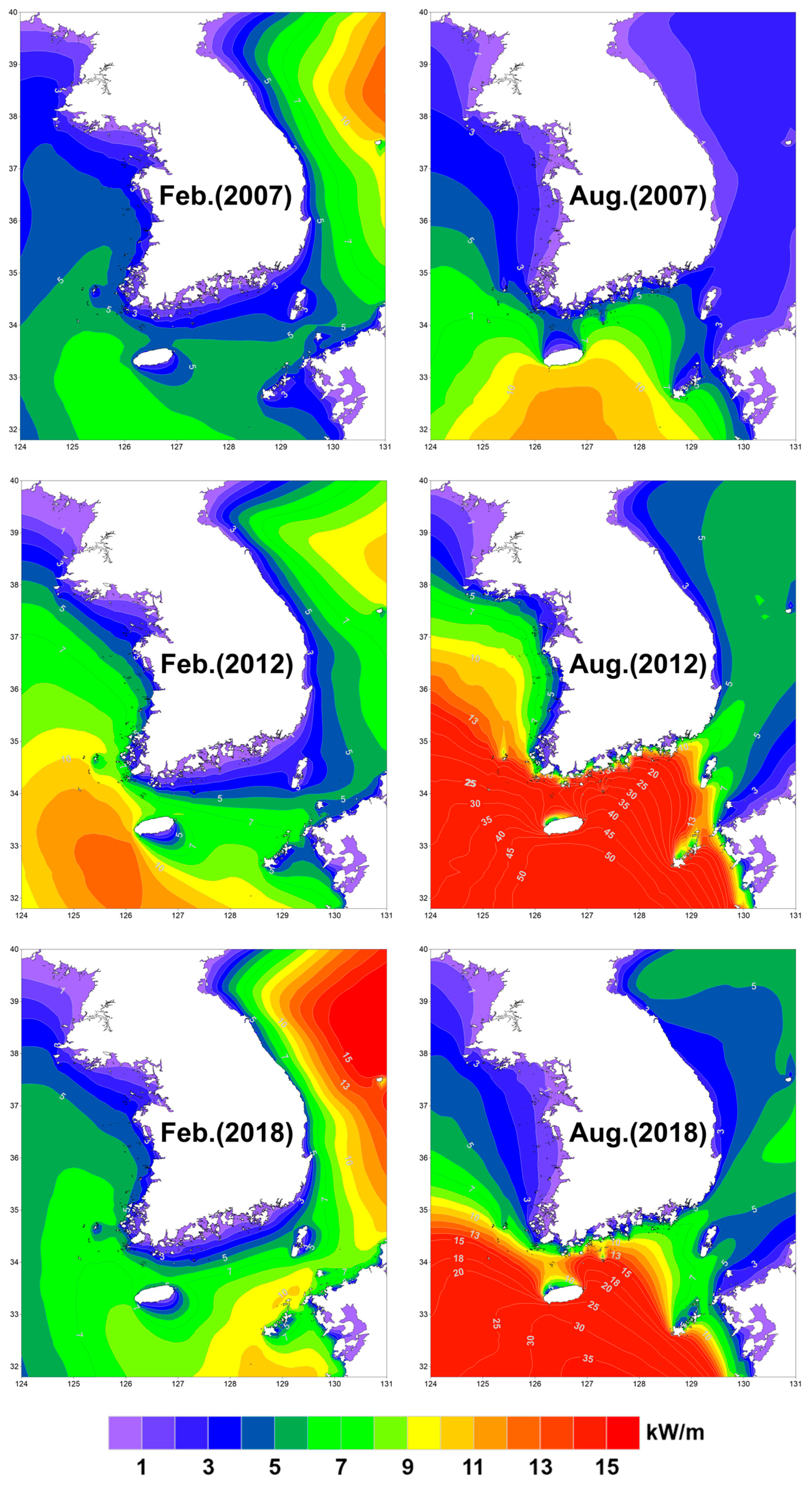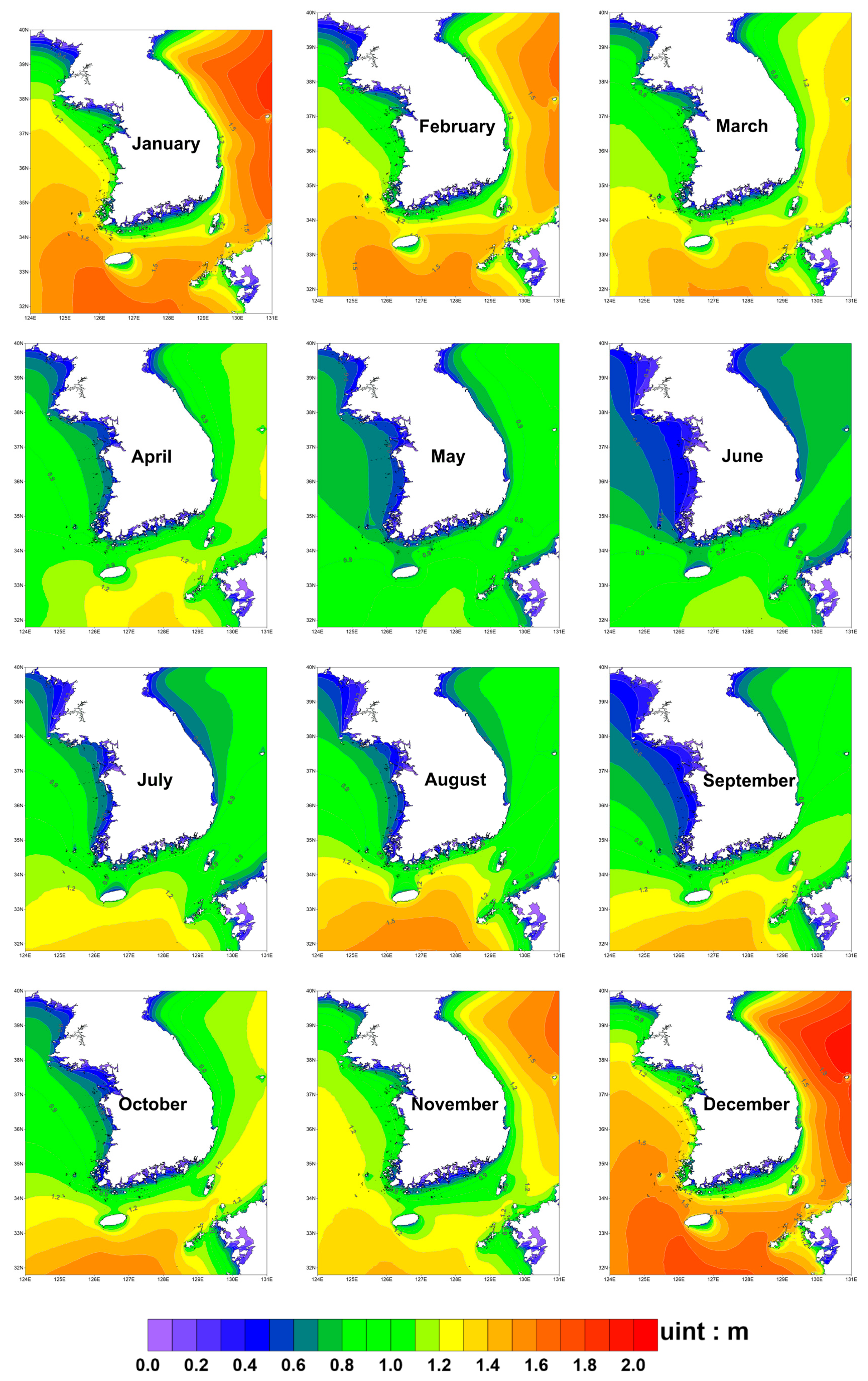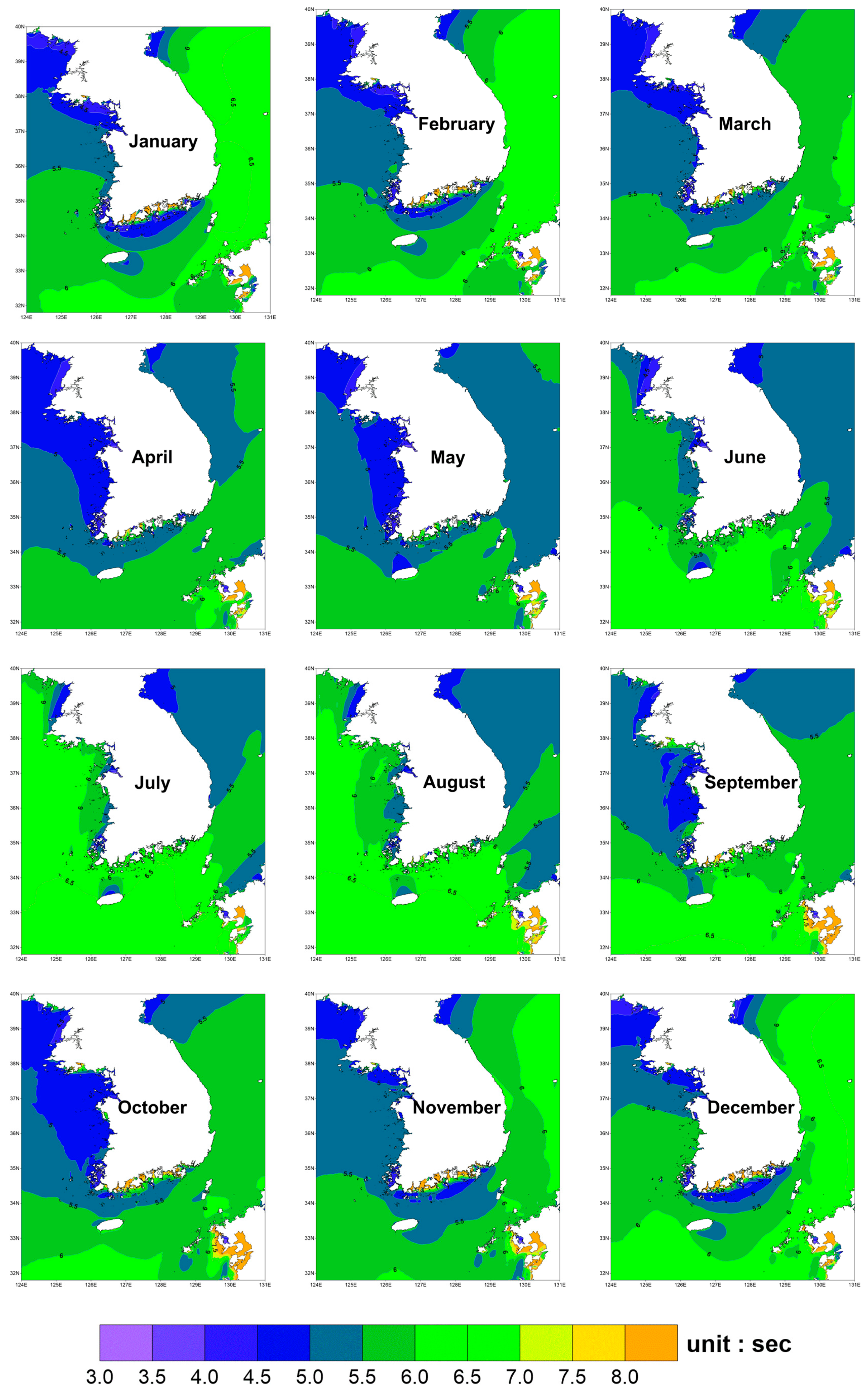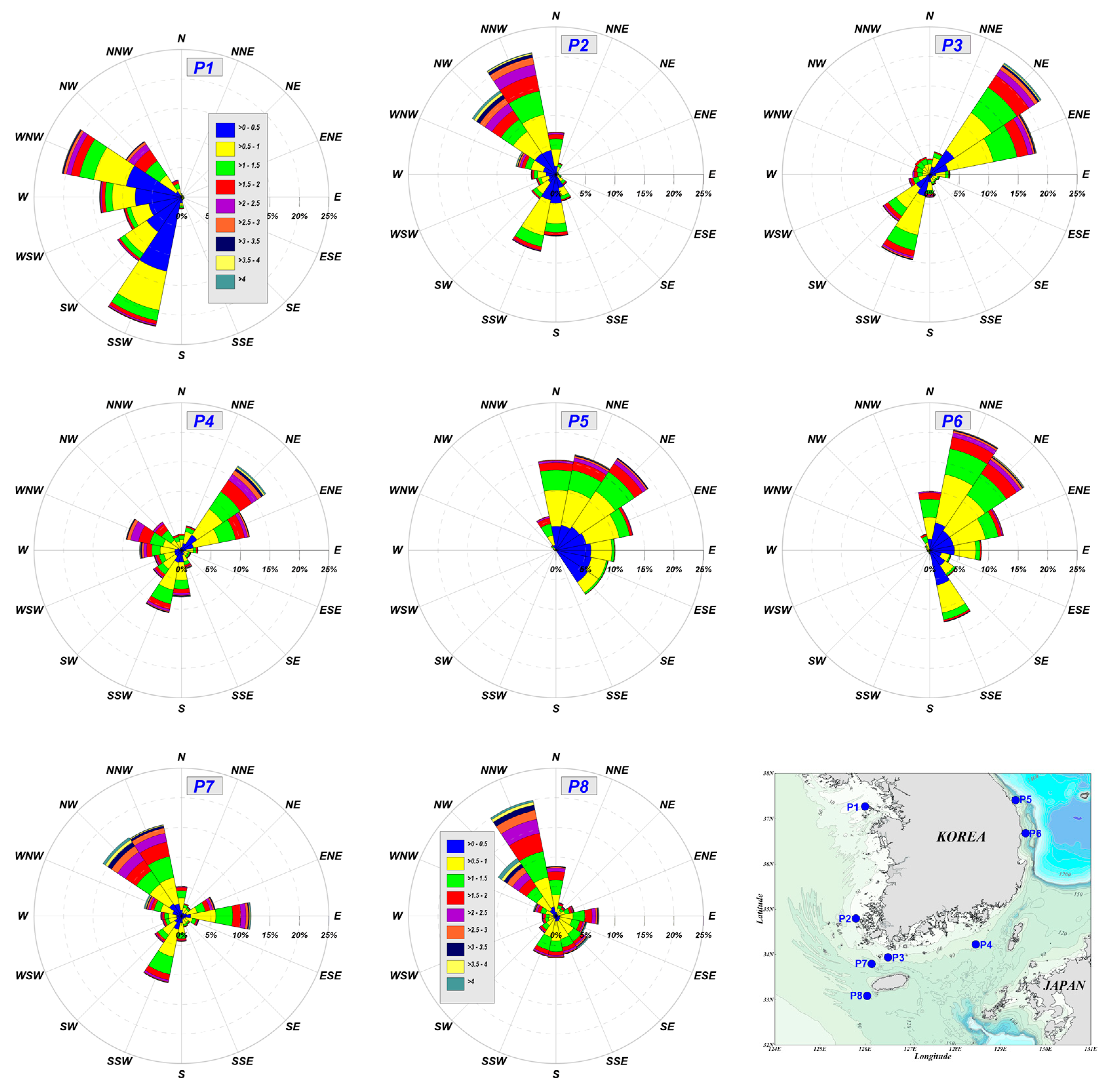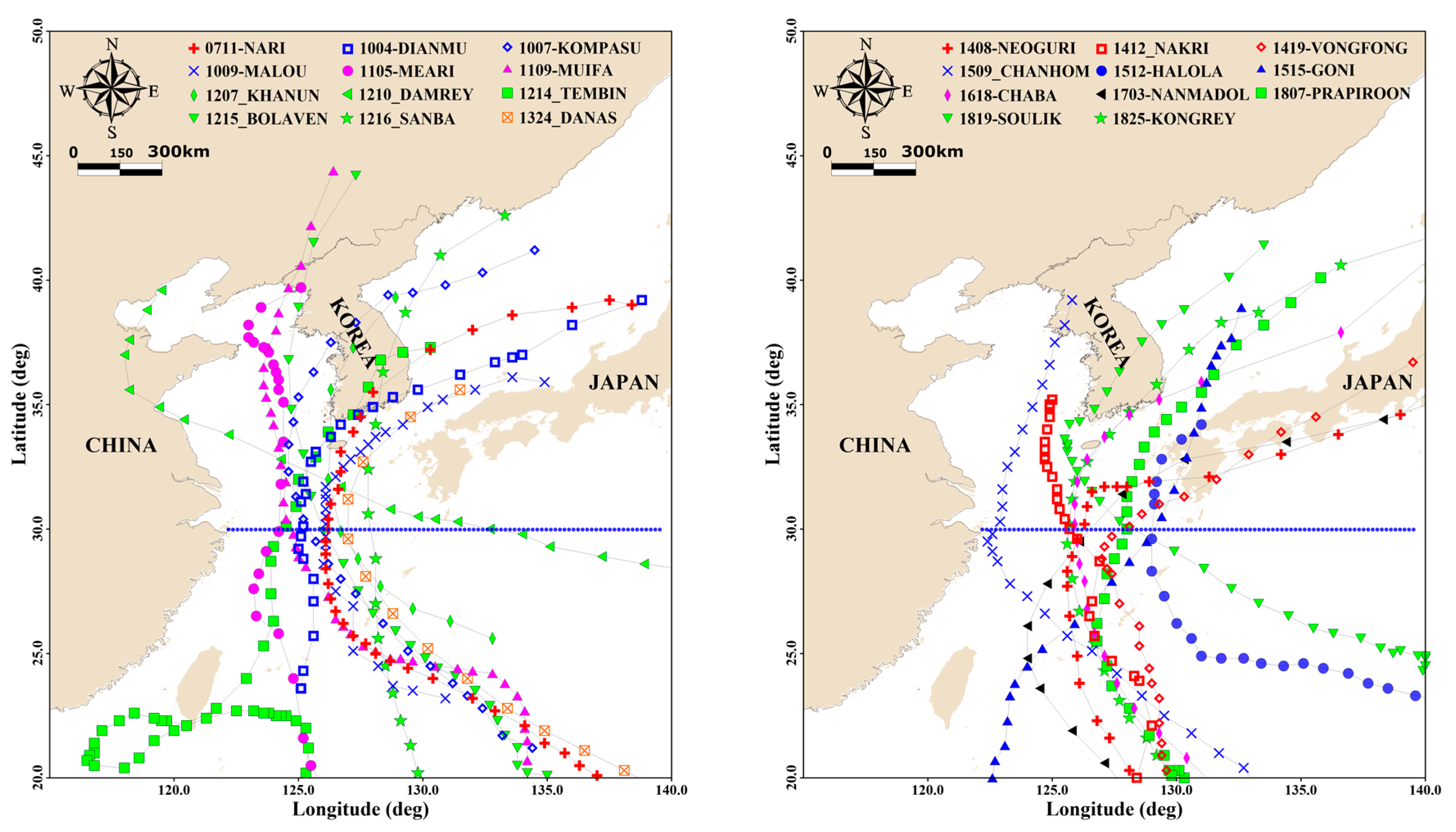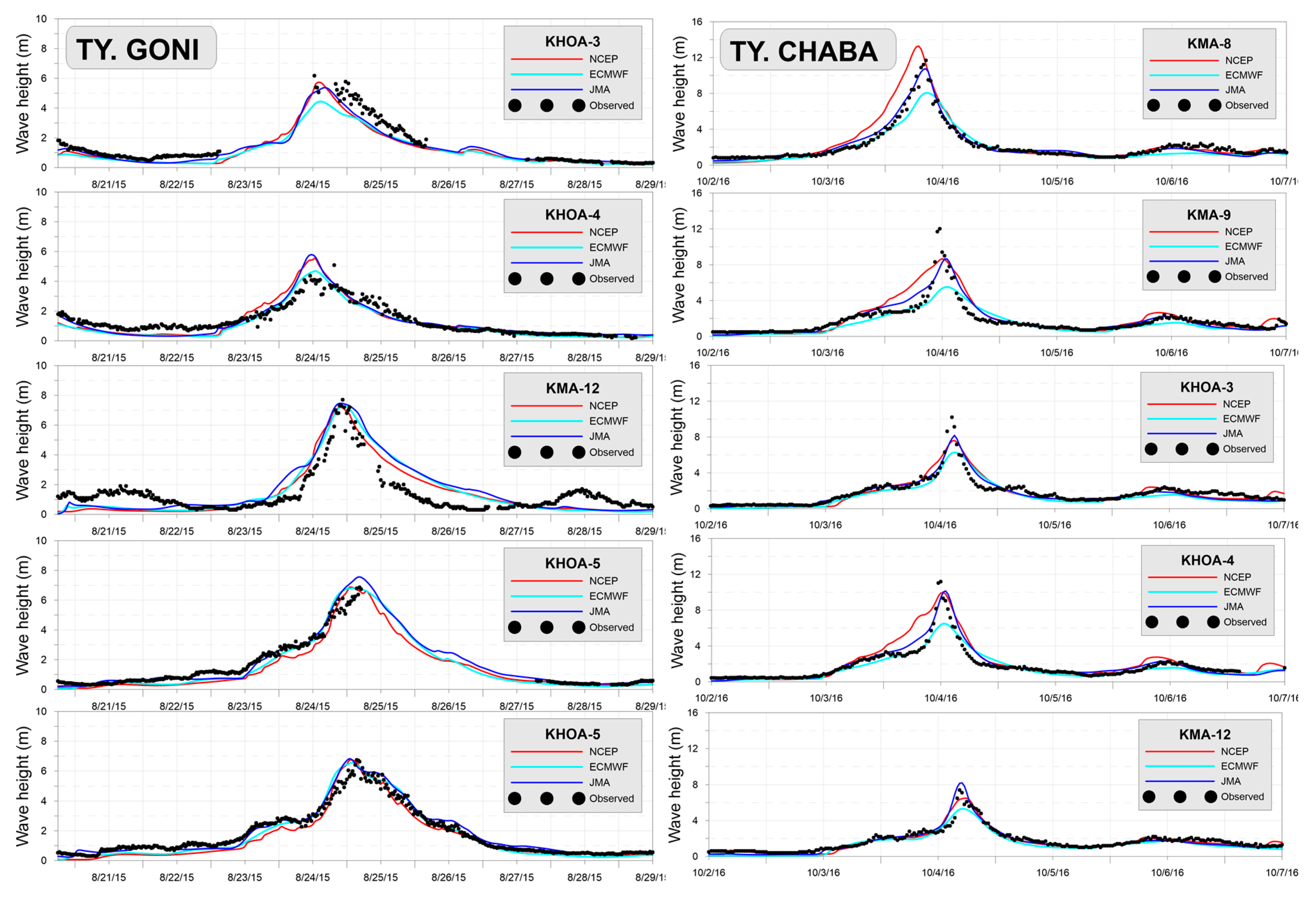Figure 1.
Locations of wave observation stations around Korean Peninsula provided by the Wave Information Network of Korea (WINK) system.
Figure 1.
Locations of wave observation stations around Korean Peninsula provided by the Wave Information Network of Korea (WINK) system.
Figure 2.
Sea bottom bathymetry of geographical area simulated by the simulating waves nearshore (SWAN) model.
Figure 2.
Sea bottom bathymetry of geographical area simulated by the simulating waves nearshore (SWAN) model.
Figure 3.
Comparison of wave parameters (wave height, period, and direction) among the three different wave bands at KMA-2 location. Case 1: 20 bands in (0.04–0.4)-Hz frequency range; Case 2: 40 bands in (0.04–0.4)-Hz frequency range; Case 3: 40 bands in (0.02–0.4)-Hz frequency range.
Figure 3.
Comparison of wave parameters (wave height, period, and direction) among the three different wave bands at KMA-2 location. Case 1: 20 bands in (0.04–0.4)-Hz frequency range; Case 2: 40 bands in (0.04–0.4)-Hz frequency range; Case 3: 40 bands in (0.02–0.4)-Hz frequency range.
Figure 4.
Measured and computed time series of significant wave heights at Korea Hydrographic and Oceanographic Agency (KHOA)-Jeju-South station in 2016.
Figure 4.
Measured and computed time series of significant wave heights at Korea Hydrographic and Oceanographic Agency (KHOA)-Jeju-South station in 2016.
Figure 5.
Scatter diagrams of measured and hindcasted significant wave heights around the Korean Peninsula over 2007–2018.
Figure 5.
Scatter diagrams of measured and hindcasted significant wave heights around the Korean Peninsula over 2007–2018.
Figure 6.
Average wave energy over 12 years from 2007 to 2018.
Figure 6.
Average wave energy over 12 years from 2007 to 2018.
Figure 7.
Yearly wave power average around the Korean Peninsula over 2007–2018.
Figure 7.
Yearly wave power average around the Korean Peninsula over 2007–2018.
Figure 8.
Four selected regions for wave power calculation in the Yellow Sea, Korea Strait, East Sea, and Jeju Island.
Figure 8.
Four selected regions for wave power calculation in the Yellow Sea, Korea Strait, East Sea, and Jeju Island.
Figure 9.
Time series of monthly overall predicted wave power around the Korean Peninsula (Yellow Sea, Korea Strait, East Sea, Jeju Island) over 2007–2018. Note that the maximum value in the Y-axis for Jeju Island is 40.
Figure 9.
Time series of monthly overall predicted wave power around the Korean Peninsula (Yellow Sea, Korea Strait, East Sea, Jeju Island) over 2007–2018. Note that the maximum value in the Y-axis for Jeju Island is 40.
Figure 10.
Monthly wave power in the Yellow Sea, Korea Strait, East Sea, and Jeju Island averaged over 12 years from 2007 to 2018.
Figure 10.
Monthly wave power in the Yellow Sea, Korea Strait, East Sea, and Jeju Island averaged over 12 years from 2007 to 2018.
Figure 11.
Time series of monthly mean wave energy computed at two selected locations for each region over 2007–2018. The orange, green, and blue lines denote the locations where the energies are computed; their distances from the shore are 2.5 (nearshore), 12.5 (medium), and 22.5 km (offshore), respectively.
Figure 11.
Time series of monthly mean wave energy computed at two selected locations for each region over 2007–2018. The orange, green, and blue lines denote the locations where the energies are computed; their distances from the shore are 2.5 (nearshore), 12.5 (medium), and 22.5 km (offshore), respectively.
Figure 12.
Monthly wave power around the Korean Peninsula over 2007–2018.
Figure 12.
Monthly wave power around the Korean Peninsula over 2007–2018.
Figure 13.
Monthly averaged wave power of February and August around the Korean Peninsula in 2007, 2012, and 2018.
Figure 13.
Monthly averaged wave power of February and August around the Korean Peninsula in 2007, 2012, and 2018.
Figure 14.
Monthly averaged wave height around the Korean Peninsula over 2007–2018.
Figure 14.
Monthly averaged wave height around the Korean Peninsula over 2007–2018.
Figure 15.
Monthly averaged wave period around the Korean Peninsula over 2007–2018.
Figure 15.
Monthly averaged wave period around the Korean Peninsula over 2007–2018.
Figure 16.
Rose diagram of averaged wave height and direction at eight selected locations in four regions around the Korean Peninsula over 2007–2018.
Figure 16.
Rose diagram of averaged wave height and direction at eight selected locations in four regions around the Korean Peninsula over 2007–2018.
Figure 17.
Paths of typhoons that affected the Korean Peninsula: (a) 2007–2013 and (b) 2014–2018.
Figure 17.
Paths of typhoons that affected the Korean Peninsula: (a) 2007–2013 and (b) 2014–2018.
Figure 18.
Measured and computed time series of significant wave heights among the three wind fields during Typhoons GONI (2015) and CHABA (2016).
Figure 18.
Measured and computed time series of significant wave heights among the three wind fields during Typhoons GONI (2015) and CHABA (2016).
Table 1.
Summary of European Centre for Medium-Range Weather (ECMWF), National Centers for Environmental Prediction (NCEP), and Japan Meteorological Agency (JMA) wind data.
Table 1.
Summary of European Centre for Medium-Range Weather (ECMWF), National Centers for Environmental Prediction (NCEP), and Japan Meteorological Agency (JMA) wind data.
| Wind Data | Spatial Resolution | Period | Time Resolution | Area |
|---|
| (°) | (h) |
|---|
| ECMWF | Set A | 1.125 | 1979.01–1993.12 | 6 | Global |
| Set B | 1.125 | 1994.04–2006.02 |
| Set C | 0.25 | 2006.03–2012.01 |
| Set D | 0.125 | 2012.02–current |
| NCEP | Set A | 0.312 | 1979.01–2010.12 | 1 | Global |
| Set B | 0.205 × 0.204 | 2011.01–current |
| JMA | 0.0625 × 0.050 | 2006.03–current | 3 | 120–150 °E, 22.4–47.6 °N |
Table 2.
Summary of wave observation data provided by the WINK system.
Table 2.
Summary of wave observation data provided by the WINK system.
| NO | Site Name | Observation Start Time | Observation Location | Water Depth |
|---|
| KMA | 1 | Deokjeokdo | 1996.07.01 | 37°14′9.96″N | 126°1′7.68″E | 37 m |
| 2 | Incheon | 2015.12.22 | 37°5′30.12″N | 125°25′44.04″E | 45 m |
| 3 | Weyeondo | 2009.10.21 | 36°15′0″N | 125°45′0″E | 58 m |
| 4 | Buan | 2015.12.22 | 35°39′30.96″N | 125°48′50.04″E | 59 m |
| 5 | Chilbaldo | 1996.07.01 | 34°47′35.88″N | 125°46′36.84″E | 36 m |
| 6 | Chujado | 2014.01.14 | 33°47′36.96″N | 126°8′27.96″E | 111 m |
| 7 | Marado | 2008.11.15 | 33°4′59.88″N | 126°1′59.88″E | 116 m |
| 8 | Seogwipo | 2015.12.22 | 33°7′41.16″N | 127°1′22.08″E | 115 m |
| 9 | Geomundo | 1997.05.01 | 34°0′5.04″N | 127°30′5.04″E | 81 m |
| 10 | Tongyeong | 2015.12.22 | 34°23′30.12″N | 128°13′30″E | 65 m |
| 11 | Geojedo | 1998.05.01 | 34°46′0.12″N | 128°54′0″E | 89 m |
| 12 | Ulsan | 2015.12.22 | 35°20′43.08″N | 129°50′29.04″E | 144 m |
| 13 | Pohang | 2008.11.15 | 36°21′0″N | 129°46′59.88″E | 372 m |
| 14 | Uljin | 2015.12.09 | 36°54′24.84″N | 129°52′27.84″E | 789 m |
| 15 | Ulreungdo | 2011.12.28 | 37°27′19.44″N | 131°6′51.84″E | 2123 m |
| 16 | Donghae | 2001.04.01 | 37°32′39.12″N | 130°0′0″E | 1520 m |
| KHOA | 1 | Jeju-South | 2012.11.16 | 32°5′25″N | 126°57′57″E | 122 m |
| 2 | Jeju Strait | 2012.11.16 | 33°54′42″N | 126°29′32″E | 67 m |
| 3 | South Sea-East | 2012.11.16 | 34°13′21″N | 128°25′8″E | 86 m |
| 4 | Korea Strait | 2012.11.16 | 34°55′8″N | 129°7′17″E | 98 m |
| 5 | Ulleungdo-NW | 2012.11.22 | 37°44′34″N | 130°36′4″E | 1307 m |
| 6 | Ulleungdo-NE | 2012.11.30 | 38°0′26″N | 131°33′9″E | 1040 m |
| MOF | 1 | Taean | 2014.07.12 | 36°43′11.5″N | 125°56′43.4″E | 26 m |
| 2 | Yosu | 2018.12.13 | 34°31′57.4″N | 127°57′56.5″E | 30 m |
| 3 | Busan | 2017.09.22 | 35°00′50″N | 128°59′48″E | 36 m |
| 4 | Ulsan | 2018.07.14 | 35°23′30.1″N | 129°22′52.0″E | 29 m |
| 5 | Kyungju | 2014.07.21 | 35°40′6.4″N | 129°28′55.1″E | 32 m |
| 6 | Pohang | 2018.05.22 | 36°02′16.34″N | 129°27′12.03″E | 22 m |
| 7 | Uljin | 2015.07.02 | 36°41′59.8″N | 129°29′24.1″E | 31 m |
| 8 | Samchuk | 2013.09.27 | 37°22′00″N | 129°14′5.2″E | 32 m |
| 9 | Sokcho | 2013.06.19 | 38°13′14.04″N | 128°35′55.38″E | 15 m |
| 10 | Gosung | 2016.04.29 | 38°21′40.4″N | 128°31′41.6″E | 32 m |
Table 3.
Numerical wave model (SWAN) setup.
Table 3.
Numerical wave model (SWAN) setup.
| Category | Contents |
|---|
| version | SWAN V40.91 (Delft University of Technology) |
| grid system | Orthogonal grid system |
| domain | Long. 120°–150°E, Lat. 22.4°–47.6 °N, (0.05° interval, 600 × 504) |
| wave spectrum | 48 components (0–360°) of wave direction |
| 20 components (0.04–0.4Hz) of frequency |
| wind data | ECMWF, NCEP, JMA (2016) |
| depth | Digital charts (KHOA) |
| water level | AHHWL |
Table 4.
Wind product verification results at wave observation stations.
Table 4.
Wind product verification results at wave observation stations.
| Site Name | R | RMSE | B |
|---|
| NCEP | ECMWF | JMA | NCEP | ECMWF | JMA | NCEP | ECMWF | JMA |
|---|
| KMA | Deokjeokdo | 0.847 | 0.892 | 0.932 | 0.302 | 0.281 | 0.290 | 0.084 | 0.092 | 0.143 |
| Incheon | 0.898 | 0.929 | 0.951 | 0.298 | 0.257 | 0.220 | 0.087 | 0.081 | 0.011 |
| Buan | 0.879 | 0.913 | 0.937 | 0.400 | 0.342 | 0.286 | 0.127 | 0.111 | 0.025 |
| Chilbaldo | 0.859 | 0.912 | 0.931 | 0.391 | 0.318 | 0.286 | 0.043 | 0.059 | 0.027 |
| Chujado | 0.945 | 0.925 | 0.943 | 0.286 | 0.315 | 0.316 | 0.155 | 0.046 | 0.037 |
| Marado | 0.864 | 0.912 | 0.920 | 0.460 | 0.398 | 0.349 | 0.183 | 0.216 | 0.099 |
| Seogwipo | 0.906 | 0.888 | 0.921 | 0.380 | 0.410 | 0.322 | 0.186 | 0.230 | 0.137 |
| Geomundo | 0.906 | 0.891 | 0.905 | 0.340 | 0.314 | 0.332 | 0.028 | 0.107 | 0.049 |
| Tongyeong | 0.887 | 0.889 | 0.923 | 0.345 | 0.336 | 0.283 | 0.070 | 0.182 | 0.002 |
| Geojedo | 0.877 | 0.899 | 0.922 | 0.382 | 0.361 | 0.277 | 0.196 | 0.221 | 0.075 |
| Ulsan | 0.922 | 0.932 | 0.936 | 0.396 | 0.408 | 0.308 | 0.245 | 0.281 | 0.113 |
| Pohang | 0.919 | 0.919 | 0.926 | 0.468 | 0.477 | 0.340 | 0.328 | 0.339 | 0.148 |
| Uljin | 0.917 | 0.916 | 0.921 | 0.538 | 0.540 | 0.390 | 0.409 | 0.413 | 0.220 |
| Ulreungdo | 0.929 | 0.940 | 0.943 | 0.480 | 0.442 | 0.345 | 0.316 | 0.293 | 0.147 |
| Donghae | 0.914 | 0.912 | 0.919 | 0.501 | 0.488 | 0.372 | 0.367 | 0.349 | 0.170 |
| KHOA | Jeju-South | 0.902 | 0.950 | 0.949 | 0.435 | 0.360 | 0.308 | 0.160 | 0.216 | 0.107 |
| Jeju Strait | 0.892 | 0.843 | 0.859 | 0.354 | 0.382 | 0.456 | 0.114 | 0.074 | 0.181 |
| South Sea-East | 0.916 | 0.925 | 0.947 | 0.322 | 0.307 | 0.266 | 0.052 | 0.146 | 0.012 |
| Korea Strait | 0.887 | 0.907 | 0.925 | 0.367 | 0.343 | 0.269 | 0.196 | 0.201 | 0.056 |
| Ulleungdo-NW | 0.931 | 0.933 | 0.938 | 0.446 | 0.418 | 0.329 | 0.302 | 0.272 | 0.100 |
| Ulleungdo-NE | 0.937 | 0.947 | 0.946 | 0.473 | 0.413 | 0.334 | 0.315 | 0.266 | 0.115 |
| Average | 0.902 | 0.913 | 0.928 | 0.398 | 0.377 | 0.318 | 0.189 | 0.200 | 0.094 |
Table 5.
Wind product verification results for wave height classes.
Table 5.
Wind product verification results for wave height classes.
| Wave Height Class | R | RMSE | B |
|---|
| NCEP | ECMWF | JMA | NCEP | ECMWF | JMA | NCEP | ECMWF | JMA |
|---|
| 0–1 m | 0.657 | 0.701 | 0.747 | 0.254 | 0.242 | 0.198 | 0.114 | 0.131 | 0.065 |
| 1–2 m | 0.626 | 0.652 | 0.699 | 0.418 | 0.404 | 0.344 | 0.238 | 0.237 | 0.122 |
| 2–3 m | 0.498 | 0.477 | 0.498 | 0.628 | 0.598 | 0.553 | 0.393 | 0.361 | 0.237 |
| >3 m | 0.611 | 0.607 | 0.667 | 1.057 | 0.847 | 0.759 | 0.664 | 0.552 | 0.343 |
| Total | 0.902 | 0.913 | 0.928 | 0.398 | 0.377 | 0.318 | 0.189 | 0.200 | 0.094 |
Table 6.
Areas for wave energy calculation in the Yellow Sea, Korea Strait, East Sea, and Jeju Island.
Table 6.
Areas for wave energy calculation in the Yellow Sea, Korea Strait, East Sea, and Jeju Island.
| Zone | Area |
|---|
| Longitude | Latitude |
|---|
| Yellow Sea | 124.0°–126.5 °E | 34.0°–38.0 °N |
| Korea Strait | 126.0°–129.5 °E | 33.5°–35.0 °N |
| East Sea | 129.0°–131.0 °E | 34.5°–38.0 °N |
| Jeju Island | 125.5°–127.5 °E | 32.5°–34.0 °N |
Table 7.
Minima and maxima of monthly wave power in the Yellow Sea (YS), Korea Strait (KS), East Sea (ES), and Jeju Island (JI).
Table 7.
Minima and maxima of monthly wave power in the Yellow Sea (YS), Korea Strait (KS), East Sea (ES), and Jeju Island (JI).
| Month | YS | KS | ES | JI |
|---|
| MIN | MAX | MIN | MAX | MIN | MAX | MIN | MAX |
|---|
| 1 | 4.0 | 8.3 | 3.4 | 6.7 | 4.8 | 12.3 | 5.5 | 11.0 |
| 2 | 3.2 | 8.6 | 2.9 | 7.2 | 5.1 | 9.7 | 4.7 | 11.0 |
| 3 | 2.3 | 9.5 | 2.6 | 10.2 | 2.7 | 13.7 | 4.9 | 11.0 |
| 4 | 1.7 | 5.2 | 2.0 | 5.9 | 2.7 | 7.3 | 2.7 | 8.2 |
| 5 | 0.6 | 2.5 | 1.1 | 4.9 | 2.1 | 4.3 | 1.6 | 6.2 |
| 6 | 0.7 | 5.0 | 1.4 | 4.1 | 0.7 | 2.8 | 2.2 | 7.3 |
| 7 | 1.4 | 5.3 | 1.7 | 7.6 | 1.2 | 5.1 | 2.4 | 14.9 |
| 8 | 1.9 | 10.9 | 2.3 | 18.2 | 1.5 | 7.9 | 3.5 | 40.4 |
| 9 | 0.9 | 4.1 | 1.5 | 9.0 | 1.5 | 11.4 | 2.4 | 13.6 |
| 10 | 2.0 | 5.3 | 1.3 | 10.3 | 2.1 | 11.2 | 1.9 | 16.7 |
| 11 | 1.6 | 8.8 | 1.3 | 6.7 | 2.6 | 9.9 | 1.9 | 9.8 |
| 12 | 5.2 | 13.3 | 3.3 | 8.6 | 5.0 | 13.7 | 6.1 | 16.7 |
| Region | 0.6 | 13.3 | 1.1 | 18.2 | 0.7 | 13.7 | 1.6 | 40.4 |
Table 8.
Averaged wave energy over 12 years from 2007 to 2018 at two selected locations for each region. Nearshore, medium, and offshore denote the distances of locations from the shore, i.e., 2.5, 12.5, and 22.5 km, respectively.
Table 8.
Averaged wave energy over 12 years from 2007 to 2018 at two selected locations for each region. Nearshore, medium, and offshore denote the distances of locations from the shore, i.e., 2.5, 12.5, and 22.5 km, respectively.
| Region | Water Depth | Distance to Shore (km) | Average Wave Energy (kW/m) | Longitude | Latitude |
|---|
| Condition | Value (m) |
|---|
| YS | YS-01 | offshore | 50.95 | 22.5 | 3.08 | 125.90 °E | 36.75 °N |
| medium | 60.10 | 12.5 | 2.96 | 126.00 °E | 36.75 °N |
| nearshore | 39.12 | 2.5 | 2.68 | 126.10 °E | 36.75 °N |
| YS-02 | offshore | 38.10 | 22.5 | 3.68 | 126.05 °E | 35.60 °N |
| medium | 33.81 | 12.5 | 3.45 | 126.15 °E | 35.60 °N |
| nearshore | 25.80 | 2.5 | 3.12 | 126.25 °E | 35.60 °N |
| KS | KS-01 | offshore | 65.68 | 22.5 | 4.63 | 127.80 °E | 34.20 °N |
| medium | 52.68 | 12.5 | 4.06 | 127.80 °E | 34.30 °N |
| nearshore | 55.62 | 2.5 | 3.24 | 127.80 °E | 34.40 °N |
| KS-02 | offshore | 75.89 | 22.5 | 4.23 | 128.60 °E | 34.50 °N |
| medium | 64.17 | 12.5 | 3.76 | 128.60 °E | 34.60 °N |
| nearshore | 58.49 | 2.5 | 2.86 | 128.60 °E | 34.70 °N |
| ES | ES-01 | offshore | 117.40 | 22.5 | 4.12 | 129.65 °E | 35.65 °N |
| medium | 77.54 | 12.5 | 3.27 | 129.55 °E | 35.65 °N |
| nearshore | 34.08 | 2.5 | 1.55 | 129.45 °E | 35.65 °N |
| ES-02 | offshore | 190.40 | 22.5 | 4.03 | 129.70 °E | 36.75 °N |
| medium | 154.10 | 12.5 | 3.61 | 129.60 °E | 36.75 °N |
| nearshore | 38.01 | 2.5 | 2.81 | 129.50°E | 36.75 °N |
| JI | JI-01 | offshore | 103.10 | 22.5 | 6.96 | 125.95°E | 33.35 °N |
| medium | 100.50 | 12.5 | 6.43 | 126.05°E | 33.35 °N |
| nearshore | 60.57 | 2.5 | 5.32 | 126.15°E | 33.35 °N |
| JI-02 | offshore | 110.40 | 22.5 | 6.98 | 126.50°E | 33.00 °N |
| medium | 111.20 | 12.5 | 5.80 | 126.50°E | 33.10 °N |
| nearshore | 84.50 | 2.5 | 4.06 | 126.50°E | 33.20 °N |
Table 9.
List of typhoons that influenced the Korean Peninsula from 2007 to 2018.
Table 9.
List of typhoons that influenced the Korean Peninsula from 2007 to 2018.
| Year | Name | Month | Central Pressure(hPa) | Maximum Wind Speed(m/s) | Radius (km) |
|---|
| 2007 | NARI | Sep. | 945 | 44 | 180 |
| 2010 | DIANMU | Aug. | 985 | 27 | 300 |
| KOMPASU | Aug. | 960 | 40 | 300 |
| MALOU | Sep. | 994 | 21 | 220 |
| 2011 | MEARI | Jun. | 980 | 30 | 480 |
| MUIFA | Jul. | 965 | 38 | 430 |
| 2012 | KHANUN | Jul. | 988 | 25 | 250 |
| DAMREY | Jul. | 975 | 34 | 250 |
| TEMBIN | Aug. | 980 | 31 | 200 |
| BOLAVEN | Aug. | 945 | 45 | 500 |
| SANBA | Sep. | 940 | 47 | 400 |
| 2013 | DANAS | Sep. | 945 | 45 | 350 |
| 2014 | NEOGURI | Jul. | 960 | 40 | 450 |
| NAKRI | Jul. | 980 | 25 | 360 |
| VONGFONG | Oct. | 975 | 33 | 340 |
| 2015 | CHANHOM | Jun. | 960 | 39 | 380 |
| HALOLA | Jul | 980 | 29 | 220 |
| GONI | Aug. | 940 | 47 | 330 |
| 2016 | CHABA | Sep. | 940 | 47 | 300 |
| 2017 | NANMADOL | Jul. | 985 | 27 | 170 |
| 2018 | PRAPIROON | Jul. | 975 | 32 | 280 |
| SOULIK | Aug. | 950 | 43 | 380 |
| KONGREY | Sep. | 975 | 32 | 420 |
